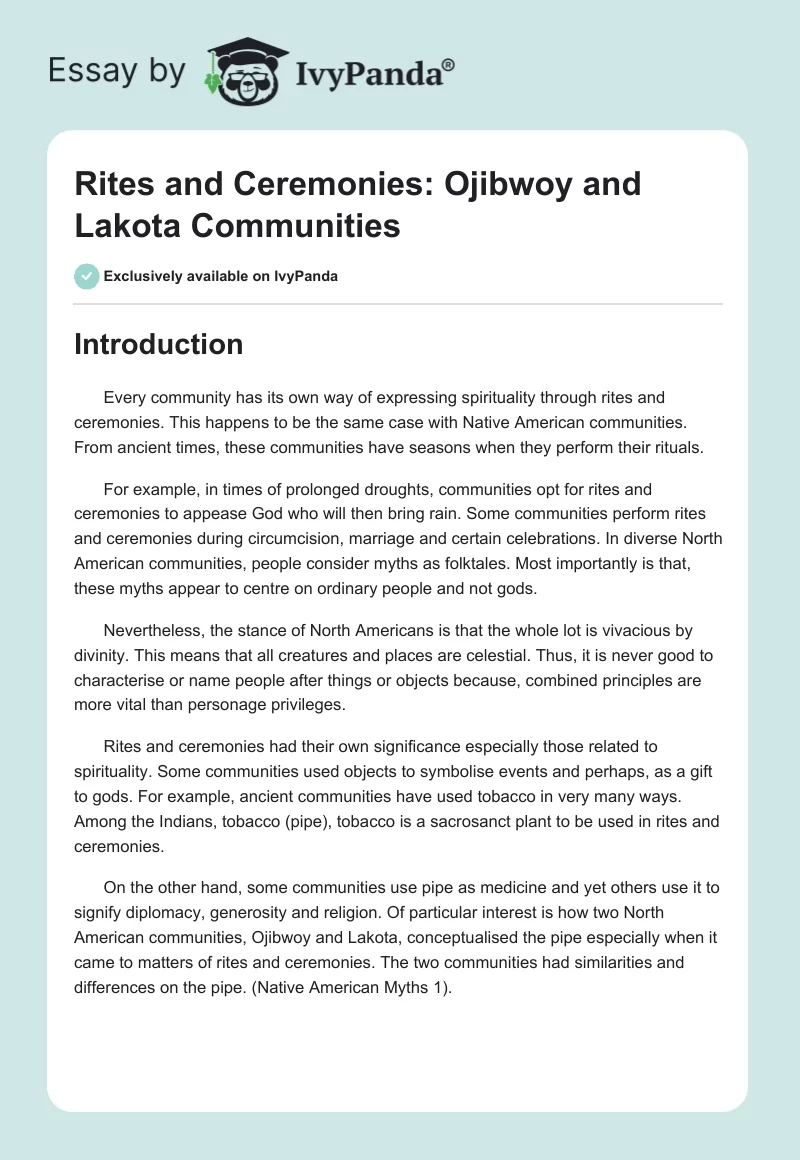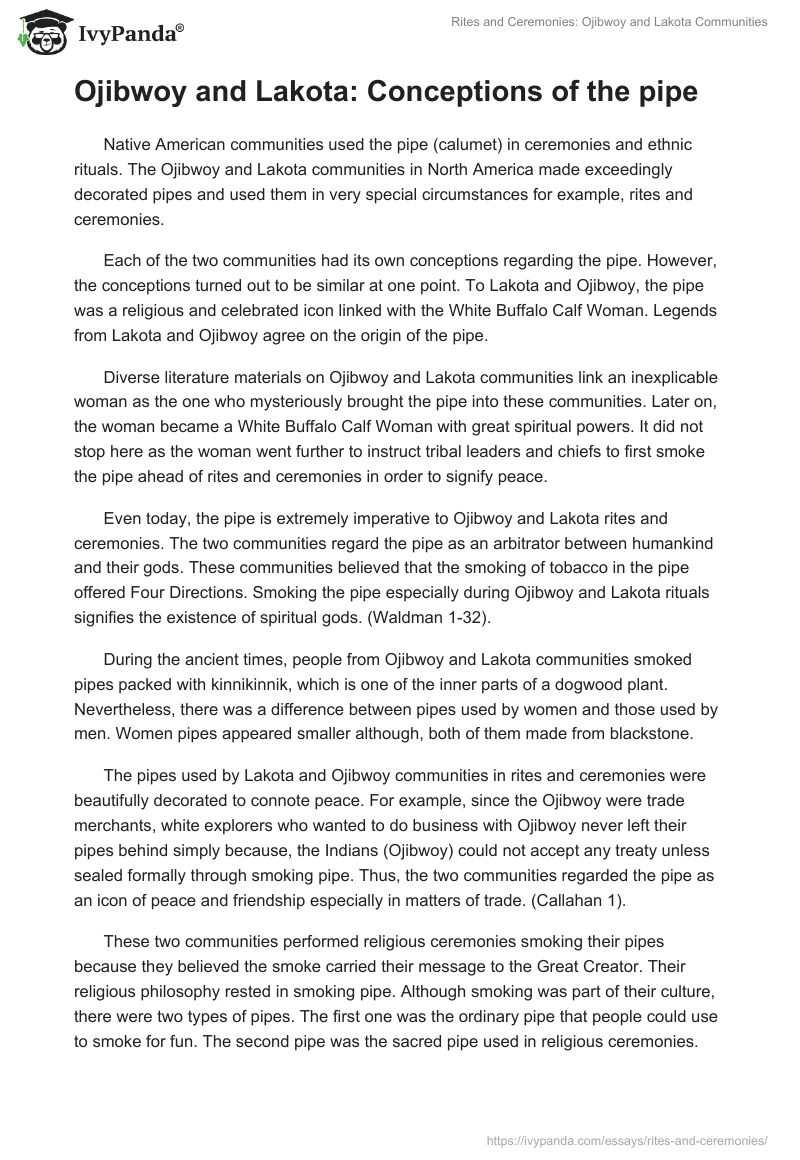Introduction
Every community has its own way of expressing spirituality through rites and ceremonies. This happens to be the same case with Native American communities. From ancient times, these communities have seasons when they perform their rituals.
For example, in times of prolonged droughts, communities opt for rites and ceremonies to appease God who will then bring rain. Some communities perform rites and ceremonies during circumcision, marriage and certain celebrations. In diverse North American communities, people consider myths as folktales. Most importantly is that, these myths appear to centre on ordinary people and not gods.
Nevertheless, the stance of North Americans is that the whole lot is vivacious by divinity. This means that all creatures and places are celestial. Thus, it is never good to characterise or name people after things or objects because, combined principles are more vital than personage privileges.
Rites and ceremonies had their own significance especially those related to spirituality. Some communities used objects to symbolise events and perhaps, as a gift to gods. For example, ancient communities have used tobacco in very many ways. Among the Indians, tobacco (pipe), tobacco is a sacrosanct plant to be used in rites and ceremonies.
On the other hand, some communities use pipe as medicine and yet others use it to signify diplomacy, generosity and religion. Of particular interest is how two North American communities, Ojibwoy and Lakota, conceptualised the pipe especially when it came to matters of rites and ceremonies. The two communities had similarities and differences on the pipe. (Native American Myths 1).
Ojibwoy and Lakota: Conceptions of the pipe
Native American communities used the pipe (calumet) in ceremonies and ethnic rituals. The Ojibwoy and Lakota communities in North America made exceedingly decorated pipes and used them in very special circumstances for example, rites and ceremonies.
Each of the two communities had its own conceptions regarding the pipe. However, the conceptions turned out to be similar at one point. To Lakota and Ojibwoy, the pipe was a religious and celebrated icon linked with the White Buffalo Calf Woman. Legends from Lakota and Ojibwoy agree on the origin of the pipe.
Diverse literature materials on Ojibwoy and Lakota communities link an inexplicable woman as the one who mysteriously brought the pipe into these communities. Later on, the woman became a White Buffalo Calf Woman with great spiritual powers. It did not stop here as the woman went further to instruct tribal leaders and chiefs to first smoke the pipe ahead of rites and ceremonies in order to signify peace.
Even today, the pipe is extremely imperative to Ojibwoy and Lakota rites and ceremonies. The two communities regard the pipe as an arbitrator between humankind and their gods. These communities believed that the smoking of tobacco in the pipe offered Four Directions. Smoking the pipe especially during Ojibwoy and Lakota rituals signifies the existence of spiritual gods. (Waldman 1-32).
During the ancient times, people from Ojibwoy and Lakota communities smoked pipes packed with kinnikinnik, which is one of the inner parts of a dogwood plant. Nevertheless, there was a difference between pipes used by women and those used by men. Women pipes appeared smaller although, both of them made from blackstone.
The pipes used by Lakota and Ojibwoy communities in rites and ceremonies were beautifully decorated to connote peace. For example, since the Ojibwoy were trade merchants, white explorers who wanted to do business with Ojibwoy never left their pipes behind simply because, the Indians (Ojibwoy) could not accept any treaty unless sealed formally through smoking pipe. Thus, the two communities regarded the pipe as an icon of peace and friendship especially in matters of trade. (Callahan 1).
These two communities performed religious ceremonies smoking their pipes because they believed the smoke carried their message to the Great Creator. Their religious philosophy rested in smoking pipe. Although smoking was part of their culture, there were two types of pipes. The first one was the ordinary pipe that people could use to smoke for fun. The second pipe was the sacred pipe used in religious ceremonies.
The two communities made their sacred pipe from two raw materials, red pipestone and a wooden stem. The wooden stem signified women power. Interestingly, only during ceremonies is when the Lakota men and women joined the red pipestone and the wooden stem. The two were kept in a special container, Container of the Heart, to signify sacredness. Before the start of the ceremony, the elders would purify the sacred pipe with sweetgrass in order to make it holy.
This was the biggest ceremony held by the Ojibwoy and Lakota people and it was actually, the basis of all other ceremonies. To them, this was the best way they communicated with the Great Creator. Their conceptions lied in the fact that, the smoke heading to the sky will take the message to God who will then take actions. It was an orchestration of submitting humankind to his Creator. (Bear 1).
On the other hand, there were differences of conceptions regarding the pipe from the two communities. Unlike Lakota community, the Ojibwoy community regards women as superior than men. This idea separates women from smoking during the actual ceremony. The conception lies in the fact that women and men cannot share the same pipe and by doing so, the value of women will diminish.
According to Lakota community, the touching of brow acts like a way of communicating with the creator. By doing this, they are also participating in the ceremony. However, women from Ojibway community do not participate in the ceremony because of their superiority over men. In fact, the myths do not allow them, to even step on ceremonial ground.
They only stand outside ceremonial grounds to watch men perform rituals while sited in circles. The power of an Ojibwoy community implies that, not even a touch of brow has effect on her. Interestingly, the sending away of Ojibway women from the ceremonial grounds is meant to prevent them from inhaling the smoke given that they are so powerful than even men participating in the ceremony.
Any woman who dares to inhale smoke from pipe will automatically fall sick. Nevertheless, women can perform their own ceremony and this time round, minus men. This is because; women have special pipes that men cannot perform rituals with. Men perceive these pipes as powerful like women and touching it will cast spell. (Callahan 1).
Sweatlodges
This is a tradition commonly practiced by ethnic communities living in North America for example, Ojibway and Lakota. These communities regard sweat lodges as environments for promoting sacred, psychological and physical health gains. In ancient times, these communities performed sweat lodges in order to get prepared for upcoming rites and ceremonies. Additionally, these communities perceived sweat lodges as imperative in answering questions awaiting them.
In most case, these communities performed sweat lodges days after or before the actual ceremony. During celebration of a certain sweat lodge, community members elected a temporary house to shelter. Inside the tent, there were stones, bonfire, firewood and water considered imperative to make the ceremony a success. Different communities had their own ways of performing sweat lodges. In overall, only three types of seat lodges dominated in North America.
These include, hot rock method, direct chamber fire and heating duct system. Nevertheless, the three sweat lodges were similar as they involved heating stones until they are red-hot and then pouring cold water on them in order to produce a moist environment. (Two Eagle Religion and Spirituality 1).
Each of these types had its own significance. Therefore, communities performed different types of sweat lodges (Inipi) in different ceremonies. Sweat lodges had diverse significance besides purification and cleansing. For example, the Lakota and Ojibway performed sweat lodges when a family member died.
They would light fire and pour water on it for four nights aimed at helping the deceased to cross over. The reason why they did this at night is that at night, evil spirits are hovering all over the place and by performing sweat lodge; they discouraged evil spirits in order to converse with the departed and perhaps say goodbye.
Thus, this ceremony was vital to these communities that hoped to send away evil spirits before entering the actual ceremony. On the other hand, men and women from Lakota and Ojibwoy tribes performed sweat lodge ceremonies as a sign of curing the sick (Doctoring Sweats). However, unlike sweat lodge ceremony for the deceased, only the sick and the traditional doctor entered the lodge as the rest will be involved in praying and singing or food preparation. (Paula 1).
Another sweat lodge ceremony is that one involved in separating people’s feeling from earthly wealth. This type of sweat lodge ceremony helped people to overcome difficult time through guidance and counselling.
Affected persons had to visit Tunkasila (elder spirits)-extremely sizzling sweats that kept people awake in order to pray without ceasing. Fasting was also necessary for God to hear such prayers. In essence, this type of seat lodge helped people communicate with their creator for guidance. Sweat lodges also helped people to cleanse their belonging in order to make them sacred again.
Here, they would perform sweat lodges on items, medicines and even the pipe. Unlike other sweat lodge ceremonies, sadness dominates such ceremonies because they believe that an unclean item is like somebody missing fresh air. This ceremony was vital especially when heading for smoking ceremonies as the pipe had to be clean from evil spirits.
The Role of Pine, the Sweat lodge, the Vision Quest and the Sundance in Contributing to Cultural Resilience among North American First Nations
Sweat lodges are paramount when it comes to preparing for smoking ceremonies. Both the pine and sweatlodges helped communities to cleanse themselves ahead of any ritual ceremony. By this way, the North American communities stayed in harmony observing their culture, a culture that exists even today. Vision quest was also imperative to people in North American as it gave them a mental insight of their wretchedness without divine intervention.
During ceremonies, people could sun dance as a sign of unity and cultural resilience. These factors helped communities in North America send away evil spirits, heal the sick, provide guidance and counselling to those troubled by external feelings, and prepare to communicate with the creator. As it turned out, these factors helped these communities to remain focused and united.
Works Cited
Bear, Ben. Cannupa – The Sacred Pipe: The Basis of Lakota Spirituality. Web.
Callahan, Kevin. An Introduction to Ojibway Culture and History. 2008. Web.
Native American Myths. 2010. Web.
Paula, Bidwell. Native American Sweat Lodge “Inipi” Ceremony. 2010. Web.
Two Eagle Religion and Spirituality. The Sweat Lodge Ceremony: A Native American Healing Tool. 2008. Web.
Waldman, Carl. Encyclopaedia of Native American Tribes. New York: Checkmark Books. 2006. Print.


